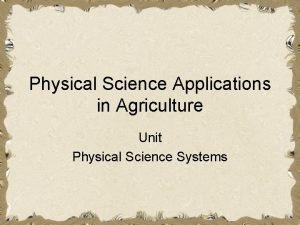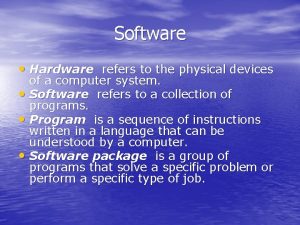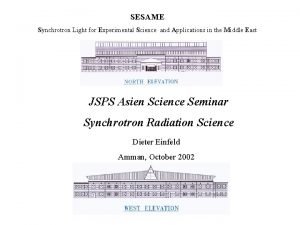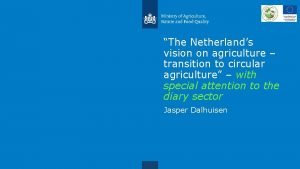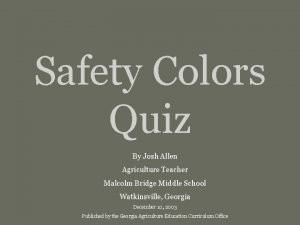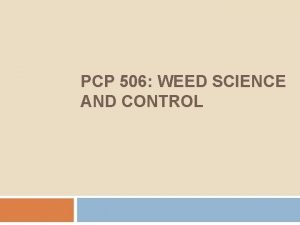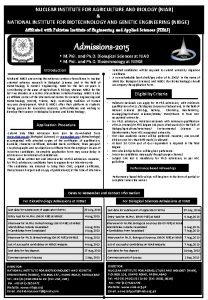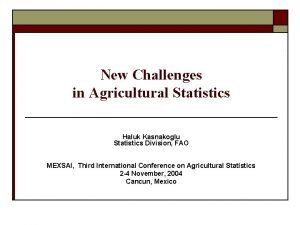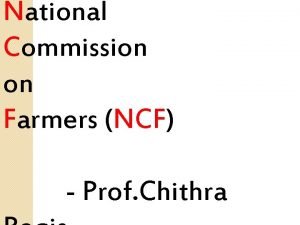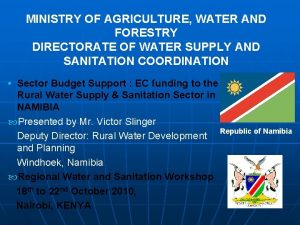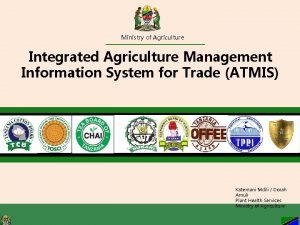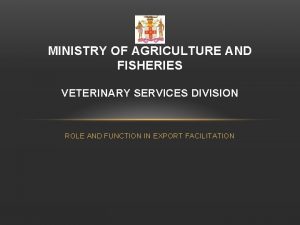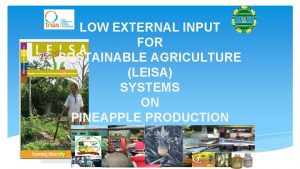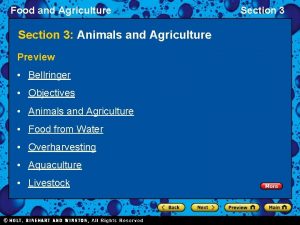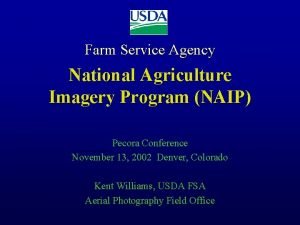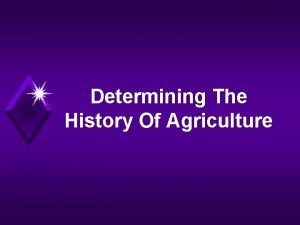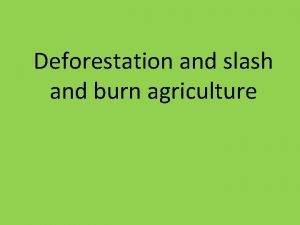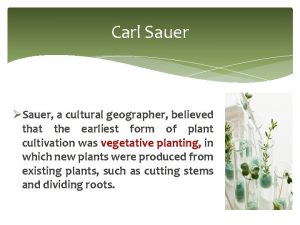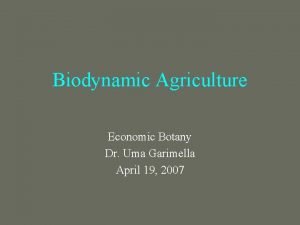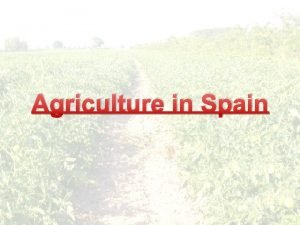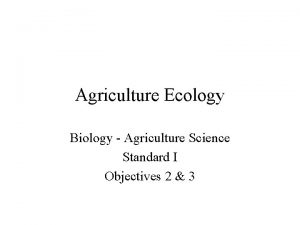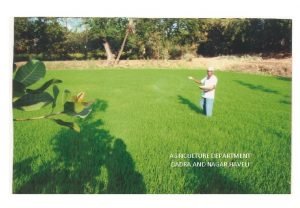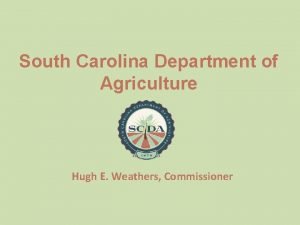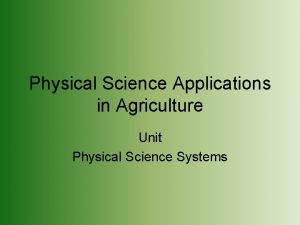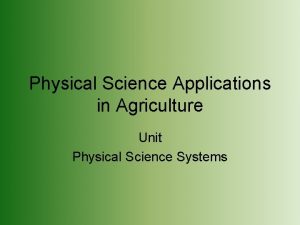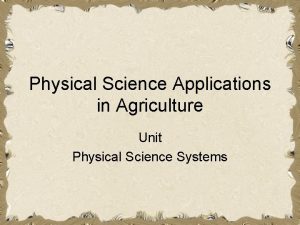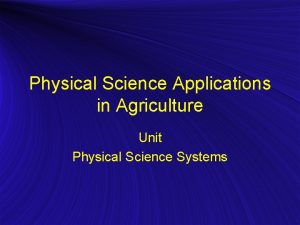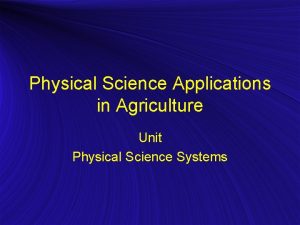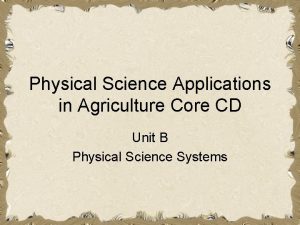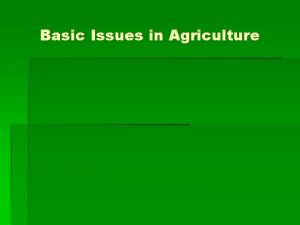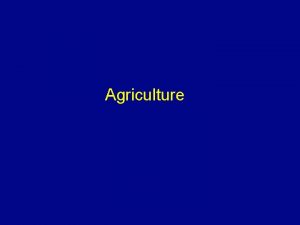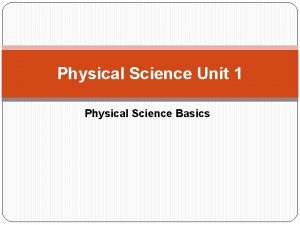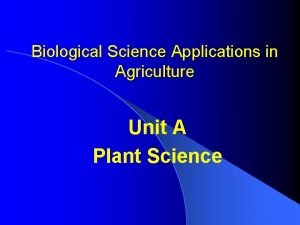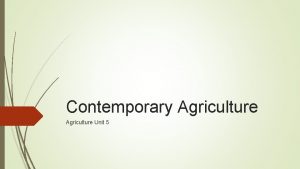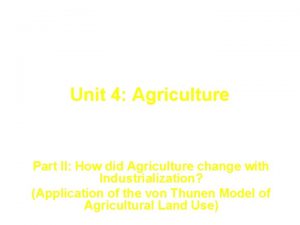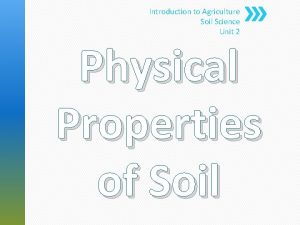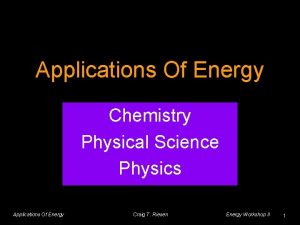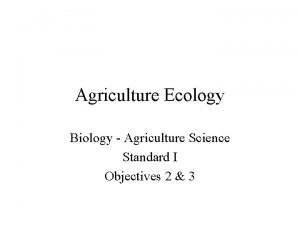Physical Science Applications in Agriculture Unit Physical Science






























































- Slides: 62

Physical Science Applications in Agriculture Unit Physical Science Systems

Problem Area Agricultural Mechanics and Machine Systems

Chemical Applications: Calibration And Metering Lesson www. agshield. com/custom. htm

How much chemical do I need? • Discuss concentrations/formulations, application rates, and how they may be determined for each product. • What does the company need to tell me about their product?

Learning Objectives 1. Explain the purpose of the pesticide label. 2. Identify the information that should be included. 3. Calculate recommended concentrations/dilutions. 4. Calibrate low pressure sprayers to achieve recommended application rates. 5. Describe the calibration of high pressure sprayers.

Terms • • Active ingredient Calibration Common name Concentration Dilution Drop spreader Establishment number • Formulation • General-use pesticide • Hose-end sprayer Inert • Ingredients • Manual compressed air sprayer

Terms • Metering • Net content of container • Notice of limitations • Precautionary statements • Restricted-use pesticides • Signal words • Solute • Solution • Solvent • Trade name

What is the purpose of the pesticide label? • Labels on pesticides provide information about the active ingredient. It is the active ingredient that kills the pest. www. ipmthailand. org

What is the purpose of the pesticide label? • Some products on the market have low amounts of active ingredient. • Use this information as a basis for deciding which product to buy. pested. unl. edu

Three important steps when dealing with the pesticide label. • Read the label – All users should discipline themselves to read and reread the label. – This is the only way to find proper handling and mixing procedure. – The label should be read completely before any handling of the chemical takes place.

Three important steps when dealing with the pesticide label • Understand the label – In addition to just reading the label, the pesticide applicator must understand the information it contains. – This may require some special training. – If the applicator does not understand some piece of information, the pesticide distributor should be contacted for clarification before the pesticide is applied.

Three important steps when dealing with the pesticide label • Follow label directions – Just knowing what should be done is not enough. – By law, users must follow label directions. – Persons using a pesticide in a manner that conflicts with the labeling can be charged with both civil and criminal penalties.

STEPS IN DEALING WITH PESTICIDE LABELS • Read the label • Understand the label • Follow directions www. uvm. edu/~jmoore/envhst/jwareham/Saftey. html

WHEN SHOULD THE LABEL BE READ? • • • Before Buying a Pesticide Before Mixing a Pesticide Before Applying a Pesticide Before Storing a Pesticide Before Disposing of Excess Pesticide or the Container

What information should be included on the pesticide label? • All pesticide labels must conform to standards set by federal law. • The goal is for pesticide labels to include all the information necessary for safe and effective use. • The label is made of two panels, a front and a back panel.

Front Label

Front panel of a label provides basic information. • Use Classification – This indicates if the pesticide is a generaluse or restricted-use pesticide. – General-use pesticides are those products that have been designated as the least hazardous pesticide materials. – Restricted-use pesticides are given this classification based on toxicity, the way the pesticide is used, and the environmental effect of the pesticide.

Front panel of a label provides basic information. • Trade (Brand) Name— – This is the product’s name given by the manufacturer. – Different manufacturers or even the same manufacturer can give a single chemical compound multiple names. – Ex. Round-up is the trade name by Monsanto for glyphosate.

Front panel of a label provides basic information. • Formulation— – This is the form in which a pesticide product is offered for sale to the user. – Active ingredients usually cannot be used alone in their pure form. – Therefore, inactive ingredients such as water, oil, surfactants, emulsifying agents, and other diluents are combined with the active ingredients to make the formulation. .

Formulation • Examples of pesticide formulations are liquid emulsifiable concentrates (E or EC), wetable powders (W or WP), dry flowables (DF), solutions (S), granules (G), and dusts (D). • Further dilution of the formulation with water or fluid fertilizers, is generally required before use.

Front panel of a label provides basic information • Common Name— – The name assigned to identify the active ingredient in the product. – Regardless of the number of trade names a certain pesticide may have, the common name remains the same. – It may be compared to the use of scientific names when dealing with plants.

Front panel of a label provides basic information • Ingredients— – This contains the name and concentration of all active ingredients in the product. – For the inert (inactive) ingredients, only the combined total concentration must be stated. www. completelake. com

Front panel of a label provides basic information • Net Contents of Container – This is the amount of the total product in the container. – This may be expressed in gallons, quarts, pints, pounds or other units. www. seehafer-refg. com

Front panel of a label provides basic information • Signal Words— – These words are required on every label to indicate the degree of toxicity and the potential danger of using each pesticide. Signal words are based on the LD 50 and LC 50 values of toxicity for the pesticide.

Signal Words • The words Danger or Danger- Poison with a skull and cross-bones (all in red) must appear on the labels of all highly toxic pesticides. chppm-www. apgea. army. mil/. . . / warning_statement. htm

Signal Words • Warning is required on the labels of all moderately toxic pesticides. • Caution must be printed on the labels of all pesticides with a low or very low toxicity pested. unl. edu/pat 2. htm

Signal Words • The child hazard warning, Keep Out of Reach of Children must also appear on the label of all pesticides, regardless of the toxicity. www. thisland. uiuc. edu/57 ways_19. html

Front panel of a label provides basic information • Precautionary Statements – Information on first aid treatment, potential environmental and human hazards, and flammability or explosion hazards. • Establishment Number – An EPA establishment number is listed to identify the plant where the individual pesticide was manufactured, packaged, or formulated.

Front panel of a label provides basic information • EPA Registration Number – Proof that the product is registered with the Environmental Protection Agency (EPA). • Name and Address of Manufacturer – Company which manufactures and distributes the pesticide is clearly identified on the label. – Normally a phone number is given in the precautionary section, so the company can be reached in case of an emergency.

Side and Back panels provide more detailed information

Side and Back panels provide more detailed information • Hazardous Materials Warning Labels – Some containers have additional symbols on their labels, as required by the United States Department of Transportation (DOT). – These symbols denote the nature of the chemicals. – The small number that appears in the lower portion of the symbol indicates which class of hazardous materials is represented.

Side and Back panels provide more detailed information • Directions for Use – This section includes specific guidelines for properly using the product. • Notice of Limitations – This section includes statements of condition of sale, warranty limitation, inherent risks, and liability limitations.

The following is a general setup for the Direction for Use section a. target pest(s) the product will control b. sites which can be treated with the pesticide c. amount of chemical to use per acre d. type of equipment and application methods that can be used e. proper mixing procedures f. when the pesticides should be applied g. reentry limitations h. guidelines for storage and disposal i. limitations on its use

How do you calculate the recommended concentrations? • When preparing formulations for agricultural applications, different substances are mixed. – For liquid solutions, the liquid that serves as the dissolving agent is the solvent; the dissolved is referred to as a solute. – The mixture is called a solution. – A solution is the homogeneous mixture of two or more substances where the substances mix as molecules, atoms, and ions.

How do you calculate the recommended concentrations? • Concentration – May be defined as the quantity of solute dissolved in a unit volume of a solution or solvent. – Concentration = quantity of solute/quantity of solution or solvent

How do you calculate the recommended concentrations? • Dilution – Inverse of concentration. – To determine the amount of material to add to a spray tank for a specific concentration or dilution, the recommended rate, the capacity of the tank, and the output of the applicator need to be known.

How do you calculate the recommended concentrations? • An important first step in calibration is preparing the solution or mixture to be metered. • In agricultural applications, such as chemical applications, we need to know how much ingredient to add to some carrier to obtain a recommendation formulation.

How do you calculate the recommended concentrations? • You have purchased a wettable powder to apply to your crop. • You have a 200 -gallon spray tank that applies 20 gallons of spray material per acre. • The label calls for 2 pounds of active ingredient (a. i. ) per acre and the wettable powder purchased is 80 percent active ingredient by weight. How much wettable powder do you add to the spray tank?

How do you calculate the recommended concentrations? • First determine the number of acres that can be sprayed per tank using the following formula: tank capacity/spray rate. • You need to know how many pounds of chemical are needed per acre. • The label recommends 2 pounds of a. i. per acre but our product only contains 80 percent a. i. by weight, thus we must make an adjustment using the following formula: • (recommended a. i. /acre) × (100%/%a. i. )

How do you calculate the recommended concentrations? • How much product must we add to each tank full? • Use the following formula to calculate: • # of acres the tank can spray × actual pounds of material required per acre.

How do you calculate the recommended concentrations? • In another application, we need to apply a liquid pesticide. • The label will recommend a recommended rate of product to apply. • Find out how much your sprayer holds and applies per 1, 000 square feet. • How many ounces must we add to the spray tank? • Use unit conversion and the unit factor method to solve the problem.

How do you calculate the recommended concentrations? • First convert recommended rate from gallons to pints per acre. • Convert the pints per acre required to ounces per 1, 000 square feet. • The last step is to determine the amount of liquid pesticide in ounces to add to the spray tank. • Use the following formula: • Sprayer size × amount of product needed per 1, 000 square feet/spray amount per 1, 000 square feet.

How do I calibrate a low-pressure sprayer? • The performance of any pesticide or fertilizer depends on proper mixing and proper application. chinasprayers. en. alibaba. . . / printablepage. html

How do I calibrate a low-pressure sprayer? • Calibration – Insures that the application equipment is applying the correct amount of material uniformly over a given area. – No matter what is being applied, we must determine how much is needed, how much area must be covered and what is the output of the application equipment. • Metering – Ability to vary the rate of the application.

Hose-end sprayer • Bottle that is connected to a garden hose. • Water flows through the hose and causes suction in the bottle. www. jerrybaker. com

Hose-end sprayer 1. To calibrate the sprayer, fill the bottle to full level. 2. Uniformly spray 1, 000 square feet area. 3. Subtract the amount remaining in the bottle from the original amount. 4. This will be the amount of spray needed to cover 1, 000 square feet. 5. Use Objective 3 to calculate the amount of product needed for the area.

Manual compressed air sprayer • 1. 2. 3. 4. A 1– 5 gallon spray tank attached to a handoperated pump that creates pressure in the tank to force solution out of the sprayer. Fill the spray tank with water. Spray a 1, 000 square foot area. Determine the amount of water required to spray the area. Fill the tank and add the recommended amount of spray concentrate to achieve the proper dilution.

Drop spreader • 1. 2. 3. 4. A spreader used to distribute a solid granular solution. Set the spreader gate at the desired setting. Fill the hopper with a measured amount by weight of inert material. Uniformly apply to a 1, 000 square foot area. Collect and weigh material from the area to determine is the desired rate is achieved.

What are the procedures to follow when calibrating sprayers? • Most performance complaints about pesticides can be traced to poor application practices. • Proper calibration helps insure that the area being sprayed receives the right amount of chemical. • Nozzle flow rate, ground speed of the sprayer, and width sprayed per nozzle are variables that affect the amount of spray material applied per acre.

What are the procedures to follow when calibrating sprayers? • The gallons of spray applied per acre can be determined by using the following equation: • GPA = GPM × 5940/MPH × W • GPA = gallons per acre • GPM = output per nozzle in gallons per minute • MPH = ground speed in miles per hour • W = effective width sprayed per nozzle • 5940 = a constant to convert gallons per minute, miles per hour, and inches to gallons per acre.

What are the procedures to follow when calibrating sprayers? • A more exact method for choosing the correct nozzle tip is to determine the gallons per minute (GPM) required for the conditions. • Select nozzles that provide this flow rate when operated within the recommended pressure range. • By following the ensuing five steps, you can select the nozzles required for each application well ahead of the spraying season.

What are the procedures to follow when calibrating sprayers? 1. Select the spray application rate in gallons per acre (GPA). • Pesticide labels recommend ranges for various types of equipment. • The spray application rate is the gallons of carrier (water, fertilizer, etc. ) and pesticide applied per treated acre.

What are the procedures to follow when calibrating sprayers? 2. Select or measure an appropriate ground speed in miles per hour (MPH) according to existing field conditions. • • Do not rely on speedometers as an accurate measure of speed. Slippage and variation in tire sizes can result in speedometer errors.

What are the procedures to follow when calibrating sprayers? 3. Determine the effective width sprayed per nozzle (W) in inches. • For broadcast spraying, W = the nozzle spacing. • For band spraying, W = the band width • For directed spraying or for drop pipes, W=row spacing (or band width)/number of nozzles per row (or band)

What are the procedures to follow when calibrating sprayers? 4. Determine the flow rate required from each nozzle in gallons per minute (GPM) by using a nozzle catalog, tables, or the following equation: – GPM = GPA × MPH × W/5940 – GPM = gallons per minute of output required from each nozzle – GPA = gallons per acre from Step 1 – MPH = miles per hour from Step 2 – W = inches sprayed per nozzle for Step 3 – 5940 = a constant to convert gallons per minute, miles per hour, and inches to gallons per acre

What are the procedures to follow when calibrating sprayers? 5. Select a nozzle that will give the flow rate determined when the nozzle is operated with the recommended pressure range. – – – Use a catalog of available nozzle tips. If it is decided to use nozzles that are already on hand, select a speed that allows you to operate within the recommended pressure. With the proper nozzle tips selected, the rest of the calibration can be completed.

What are the procedures to follow when calibrating sprayers? • Determine the required flow rate for each nozzle in ounces per minute (OPM). • To convert GPM to OPM, use the following equation. • OPM = GRM H 128 • (1 gallon = 128 fluid ounces)

What are the procedures to follow when calibrating sprayers? • Collect the output from one of the nozzles in a container marked in ounces. 1. Check several nozzles to determine whether their outputs fall within 5 percent of the desired OPM. 2. If it becomes impossible to obtain the desired output within the recommended range of operating pressures, select larger or smaller nozzle tips or a new ground speed, then recalibrate. • It is important for spray nozzles to be operated within the recommended pressure range, which indicates the pressure required at the nozzle tip.

What are the procedures to follow when calibrating sprayers? • Determine the amount of pesticide needed for each tankful or for the acreage to be sprayed. • Add the pesticide to a partially filled tank of carrier (water, fertilizer, etc. ), then add the carrier to the desired level with continuous agitation.

What are the procedures to follow when calibrating sprayers? • Operate the sprayer in the field at the ground speed measured and at the pressure determined. • After spraying a known number of acres, check the liquid level in the tank to verify that the application rate is correct.

What are the procedures to follow when calibrating sprayers? • Check the nozzle flow rate frequently. • Adjust the pressure to compensate for small changes in nozzle output due to nozzle wear or variations in other spraying components. • Replace nozzle tips and recalibrate when the output has changed 10 percent or more from that of a new nozzle, or when the pattern has become uneven.

Review/Summary • What is the purpose of the pesticide label? • What information should be included on the pesticide label? • How do you calculate the recommended concentrations? • How do I calibrate a low-pressure sprayer?
 Physical factors influencing agriculture
Physical factors influencing agriculture Physical factors influencing agriculture
Physical factors influencing agriculture Physical factors influencing agriculture
Physical factors influencing agriculture Unit 6 review questions
Unit 6 review questions Main branches of science
Main branches of science Natural science vs physical science
Natural science vs physical science What your favorite subject
What your favorite subject Hardware refers to the physical devices of a
Hardware refers to the physical devices of a Elements of computer
Elements of computer Light: science & applications
Light: science & applications Novel data science applications
Novel data science applications Vital villages thriving towns introduction
Vital villages thriving towns introduction Circular agriculture netherlands
Circular agriculture netherlands Hunters and gatherers
Hunters and gatherers Heisa agriculture
Heisa agriculture Acronym antonym
Acronym antonym Safety colors in agriculture
Safety colors in agriculture Seed agriculture hearths
Seed agriculture hearths Woody stem parts
Woody stem parts Weed science definition
Weed science definition Paid internships in germany
Paid internships in germany What are the ict tools used in agriculture
What are the ict tools used in agriculture Nuclear institute for agriculture and biology
Nuclear institute for agriculture and biology 10 importance of agriculture
10 importance of agriculture Component of agricultural renewal action plan
Component of agricultural renewal action plan Mian nawaz sharif agriculture university multan
Mian nawaz sharif agriculture university multan Ministry of agriculture, water and forestry directorates
Ministry of agriculture, water and forestry directorates Agricultural trade management information system
Agricultural trade management information system Veterinary services division
Veterinary services division Low external input sustainable agriculture
Low external input sustainable agriculture Logframe example
Logframe example Human impact on agriculture
Human impact on agriculture Agribusiness ap human geography
Agribusiness ap human geography Konya food and agriculture university
Konya food and agriculture university Section 3 animals and agriculture
Section 3 animals and agriculture Fl dept of agriculture
Fl dept of agriculture National agriculture imagery program
National agriculture imagery program E learning portal on agricultural education
E learning portal on agricultural education Agriculture sangam was developed
Agriculture sangam was developed Sinclair theory
Sinclair theory Disruptive agricultural technology
Disruptive agricultural technology Learning objectives of agriculture
Learning objectives of agriculture Define slash and burn agriculture
Define slash and burn agriculture Chapter 24 nuclear chemistry answer key
Chapter 24 nuclear chemistry answer key Carl sauer agriculture
Carl sauer agriculture Advantages of biodynamic agriculture
Advantages of biodynamic agriculture Agricultural economics importance
Agricultural economics importance Importance of agriculture
Importance of agriculture Agriculture then and now
Agriculture then and now Where did agriculture originate
Where did agriculture originate Agriculture in spain
Agriculture in spain Biology and agriculture
Biology and agriculture Irrigation projects in dadra & nagar haveli
Irrigation projects in dadra & nagar haveli Extensive farming definition ap human geography
Extensive farming definition ap human geography Sinclair model of agriculture
Sinclair model of agriculture Agile agriculture
Agile agriculture Radioactive tracers in agriculture
Radioactive tracers in agriculture How did agriculture originate
How did agriculture originate Value-added agriculture
Value-added agriculture Geography of the southeast region
Geography of the southeast region Limon soil france
Limon soil france Sc department of agriculture
Sc department of agriculture Ministry of agriculture serbia
Ministry of agriculture serbia
